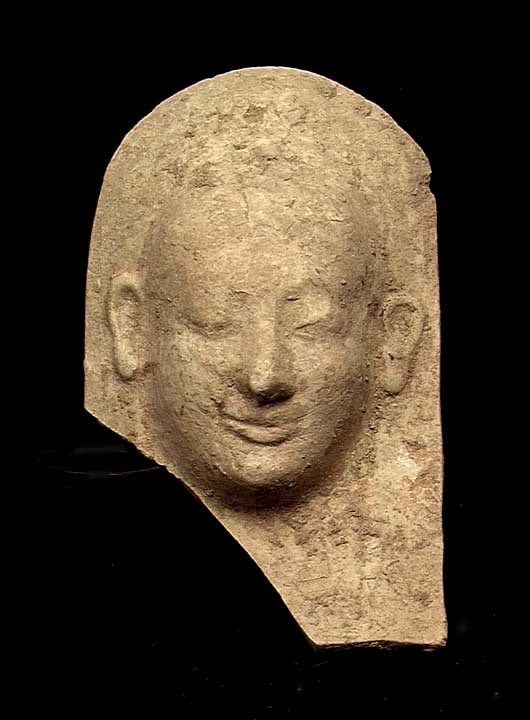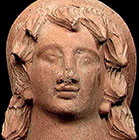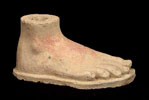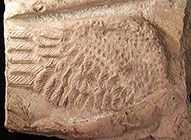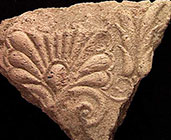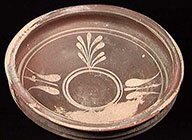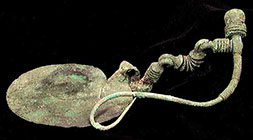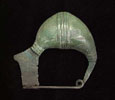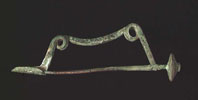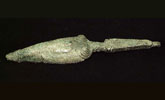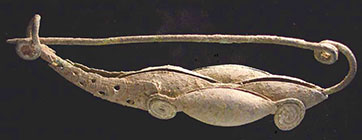Treasures Of Pre-Roman Italy
SCULPTURE POTTERY METALWORK
Map of Italy c. 400 BC.
ETRUSCAN TERRA COTTA SCULPTURE
8291. FINE ETRUSCAN TERRA COTTA HEAD, c. 3rd century BC. Large head of a young lady wearing earrings with beautiful serene smile and thick locks of hair emerging from under her veil. 4.5 x 5 x 7.5". Rare. Provenance: The Paul Suttman collection. Acquired by Suttman in the 1960's when he lived in Italy as a fellow of the American Academy of Rome. Three time recipient of the prestigious Prix de Rome Paul Suttman (1933-1993) was an internationally known American sculptor who produced many impressionistic figurative works in bronze. Mr. Suttman's work is represented in the Museum of Modern Art, the Morgan Library, the University of Michigan Museum of Art, and the Hirshhorn Museum and Sculpture Garden in Washington. More information on Suttman can be found at NY times obituary. Acquired by the current owner from the Suttman estate in the 1990's.
9650. ETRUSCAN TERRA COTTA HEAD OF A YOUNG MAN, c. 4th century BC. The large strongly modeled head with the wild hair and heavy brow usually associated with representations of Alexander the Great. 5.5 x 6 x 7 inches. Chip to left rear edge. An exceptional example of ancient classical art. Very rare. On custom stand. Provenance: The Paul Suttman collection. Acquired by Suttman in the 1960's when he lived in Italy as a fellow of the American Academy of Rome. Three time recipient of the prestigious Prix de Rome Paul Suttman (1933-1993) was an internationally known American sculptor who produced many impressionistic figurative works in bronze. Mr. Suttman's work is represented in the Museum of Modern Art, the Morgan Library, the University of Michigan Museum of Art, and the Hirshhorn Museum and Sculpture Garden in Washington. More information on Suttman can be found at NY times obituary. Acquired by the current owner from the Suttman estate in the 1990's.
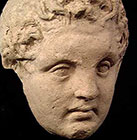
9718. EXQUISITE ETRUSCAN TERRA COTTA HEAD OF A YOUTH, c. 4th century BC. The very expressive and realistic terra cotta head of a young man with sharp nose and deep set eyes. 4.5 x 5 x 5.5 inches. An exceptional example of the excellence of ancient Etruscan terra cotta portrait art. Rare this nice. On custom stand. Provenance: The Paul Suttman collection. Acquired by Suttman in the 1960's when he lived in Italy as a fellow of the American Academy of Rome. Three time recipient of the prestigious Prix de Rome Paul Suttman (1933-1993) was an internationally known American sculptor who produced many impressionistic figurative works in bronze. Mr. Suttman's work is represented in the Museum of Modern Art, the Morgan Library, the University of Michigan Museum of Art, and the Hirshhorn Museum and Sculpture Garden in Washington. More information on Suttman can be found at NY times obituary. Acquired by the current owner from the Suttman estate in the 1990's.
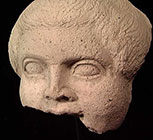
8705. AN ETRUSCAN RELIEF FRAGMENT, ca. 5th-4th century BC. The terra cotta fragment with the wing and arm of a Victory holding a wreath. 5.5 x 6 inches. Excellent style. Provenance: The Paul Suttman collection. Acquired by Suttman in the 1960's when he lived in Italy as a fellow of the American Academy of Rome. Three time recipient of the prestigious Prix de Rome Paul Suttman (1933-1993) was an internationally known American sculptor who produced many impressionistic figurative works in bronze. Mr. Suttman's work is represented in the Museum of Modern Art, the Morgan Library, the University of Michigan Museum of Art, and the Hirshhorn Museum and Sculpture Garden in Washington. More information on Suttman can be found at NY times obituary. Acquired by the current owner from the Suttman estate in the 1990's.
8706. AN ETRUSCAN RELIEF FRAGMENT, ca. 5th-4th century BC. The terra cotta fragment with a molded palmette and lily stalk. 4.75 x 5 inches. Excellent style. Provenance: The Paul Suttman collection. Acquired by Suttman in the 1960's when he lived in Italy as a fellow of the American Academy of Rome. Three time recipient of the prestigious Prix de Rome Paul Suttman (1933-1993) was an internationally known American sculptor who produced many impressionistic figurative works in bronze. Mr. Suttman's work is represented in the Museum of Modern Art, the Morgan Library, the University of Michigan Museum of Art, and the Hirshhorn Museum and Sculpture Garden in Washington. More information on Suttman can be found at NY times obituary. Acquired by the current owner from the Suttman estate in the 1990's.
ETRUSCAN & VILLANOVAN POTTERY
VERY RARE MATCHING SET 12981. LARGE PAIR OF ETRUSCAN KANTHAROI, c. 4th cent. BC. Two thin walled black glazed kantharoi with carinated bottoms and arched strap handles attached to the flared lips. On high pedestal bases. Each 9.5 x 13 inches. Possible near invisible professional repair to one handle, otherwise excellent original intact condition with very light calcium deposits attesting authenticity. Very rare matching pair especially this large and almost never seen on the market. Provenance: Acquired from Harmer Rooke Galleries sale #073, lot 250 12/2/95 with tags (attributed there as Apulian, c. 320 BC). Reverse view.
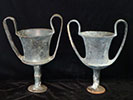
8286. RARE ITALIC POLYCHROME BOWL, ca. 6th-4th century BC. With painted floral patterns. Some glaze abrasion. 6.9". Very rare. Provenance: The Paul Suttman collection. Acquired by Suttman in the 1960's when he lived in Italy as a fellow of the American Academy of Rome. Three time recipient of the prestigious Prix de Rome Paul Suttman (1933-1993) was an internationally known American sculptor who produced many impressionistic figurative works in bronze. Mr. Suttman's work is represented in the Museum of Modern Art, the Morgan Library, the University of Michigan Museum of Art, and the Hirshhorn Museum and Sculpture Garden in Washington. More information on Suttman can be found at NY times obituary. Acquired by the current owner from the Suttman estate in the 1990's.
ETRUSCAN, ITALIC & SAMNITE METALWORK
7250. RARE VILLANOVAN MULTIPLE 'BOAT' FIBULA, 8th-6th century BC. The fibula with four boats, spirals and a long intact pin. 11.5 cm. Extremely rare type.

